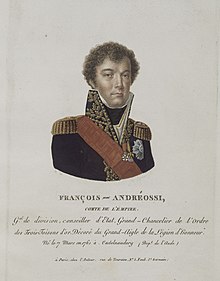Antoine-François Andréossy
Count Antoine-François Andréossy (born March 6, 1761 in Castelnaudary , † September 10, 1828 in Montauban ) was a French general and statesman.
Life
Andréossy entered the Dutch service as an artillery lieutenant in 1781, but was taken prisoner by the Prussians in Holland in 1787 and later participated in the campaigns of the Revolutionary War with distinction. Promoted to Chef de brigade during the siege of Mantua , he and General Joubert brought the flags captured by the Italian army to the Directory in 1796 and then took part in Bonaparte's march to Egypt as Général de brigade .
In the "Description de l'Egypte" the excellent descriptions of the roadstead of Damiette, the mouths of the Nile, the lake Mensaleh etc. a. by Andréossy. Returning to Paris with Bonaparte, Andréossy, as Chief of the General Staff, made a major contribution to the success of the Revolution of the 18th Brumaire . For this, Bonaparte placed him at the head of artillery and geniuses and appointed him artillery commander of Strasbourg and general de division .
In 1800 Andréossy, after having previously been Governor of Mainz , became Chief of the General Staff of the Franco-Batavian Army, then Director of the War Depot and, in 1802, envoy to London. From 1805 to 1807 he fought in Germany and, raised to the rank of count, held the legation post in Vienna until 1809. After the war with Austria, during which he was governor of Vienna, he went as an envoy to Constantinople, but was in 1814 by Louis XVIII. recalled.
During the Hundred Days he rejoined Napoleon and was appointed peer and president of the section for the war. After the defeat at Waterloo , he commanded the 1st Military Division and went to the Allied headquarters with four other commissioners to broker an armistice. He declared himself in favor of the Restoration of the Bourbons , but withdrew into private life and occupied himself exclusively with scientific work until he was appointed member of the Royal Society for the Improvement of Prisons in 1819, director of catering for the army in 1821 and deputy in 1827 was chosen in what position he held to the opposition. Since 1826 also a member of the Académie des Sciences , he died on September 10, 1828 in Montauban.
Honors
His name is entered on the triumphal arch in Paris in the 24th column.
Works
- Histoire du canal du Midi (2nd edition, Par. 1805, 2 vols.), Which his great-grandfather François Andréossy (1633–88) had built;
- Relation de la campagne sur le Mein et la Rednitz de l'armée gallo-batave (1802); * Constantinople et le Bosphore de Thrace pendant les années 1812-14 et pendant l'année 1826 (1828; German, Leipzig 1828);
- Opération des pontonniers francais en Italie pendant les campagnes de 1795 à 1797 (from his estate, 1843).
| predecessor | Office | successor |
|---|---|---|
| Louis-Guillaume Otto |
French Ambassador to the United Kingdom 1803-1804 |
Claude-Louis-Raoul de La Châtre (from 1814) |
| Alexandre-François de La Rochefoucauld |
French ambassador to Austria 1806 to 1809 |
Louis-Guillaume Otto |
| Horace-François Sébastiani |
French ambassador to the Ottoman Empire 1812 to 1815 |
Charles François Riffardeau de Rivière |
| personal data | |
|---|---|
| SURNAME | Andréossy, Antoine-François |
| ALTERNATIVE NAMES | André François d 'Andréossi, Franz Andréossi |
| BRIEF DESCRIPTION | French general and statesman |
| DATE OF BIRTH | March 6, 1761 |
| PLACE OF BIRTH | Castelnaudary |
| DATE OF DEATH | September 10, 1828 |
| Place of death | Montauban |
